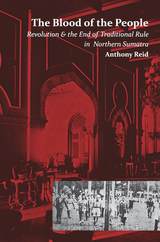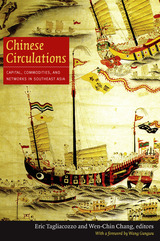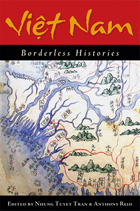3 books about Reid, Anthony

The Blood of the People
Revolution and the End of Traditional Rule in Northern Sumatra
Anthony Reid
National University of Singapore Press, 2014
In northern Sumatra, as in Malaya, colonial rule embraced an extravagant array of sultans, rajas, datuks and ulèëbalangs. In Malaya the traditional Malay elite served as a barrier to revolutionary change and survived the transition to independence, but in Sumatra a wave of violence and killing wiped out the traditional elite in 1945‒46. Anthony Reid’s The Blood of the People, now available in a new edition, explores the circumstances of Sumatra’s sharp break with the past during what has been labelled its “social revolution”.
The events in northern Sumatra were among the most dramatic episodes of Indonesia’s national revolution, and brought about more profound changes even than in Java, from where the revolution is normally viewed. Some ethnic groups saw the revolution as a popular, peasant-supported movement that liberated them from foreign rule. Others, though, felt victimised by a radical, levelling agenda imposed by outsiders. Java, with a relatively homogeneous population, passed through the revolution without significant social change. The ethnic complexity of Sumatra, in contrast, meant that the revolution demanded an altogether new “Indonesian” identity to override the competing ethnic categories of the past.
The events in northern Sumatra were among the most dramatic episodes of Indonesia’s national revolution, and brought about more profound changes even than in Java, from where the revolution is normally viewed. Some ethnic groups saw the revolution as a popular, peasant-supported movement that liberated them from foreign rule. Others, though, felt victimised by a radical, levelling agenda imposed by outsiders. Java, with a relatively homogeneous population, passed through the revolution without significant social change. The ethnic complexity of Sumatra, in contrast, meant that the revolution demanded an altogether new “Indonesian” identity to override the competing ethnic categories of the past.
[more]

Chinese Circulations
Capital, Commodities, and Networks in Southeast Asia
Eric Tagliacozzo and Wen-Chin Chang, eds.
Duke University Press, 2011
Chinese merchants have traded with Southeast Asia for centuries, sojourning and sometimes settling, during their voyages. These ventures have taken place by land and by sea, over mountains and across deserts, linking China with vast stretches of Southeast Asia in a broad, mercantile embrace. Chinese Circulations provides an unprecedented overview of this trade, its scope, diversity, and complexity. This collection of twenty groundbreaking essays foregrounds the commodities that have linked China and Southeast Asia over the centuries, including fish, jade, metal, textiles, cotton, rice, opium, timber, books, and edible birds’ nests. Human labor, the Bible, and the coins used in regional trade are among the more unexpected commodities considered. In addition to focusing on a certain time period or geographic area, each of the essays explores a particular commodity or class of commodities, following its trajectory from production, through exchange and distribution, to consumption. The first four pieces put Chinese mercantile trade with Southeast Asia in broad historical perspective; the other essays appear in chronologically ordered sections covering the precolonial period to the present. Incorporating research conducted in Chinese, Japanese, Vietnamese, Thai, Burmese, Malay, Indonesian, and several Western languages, Chinese Circulations is a major contribution not only to Sino-Southeast Asian studies but also to the analysis of globalization past and present.
Contributors. Leonard Blussé, Wen-Chin Chang, Lucille Chia, Bien Chiang, Nola Cooke, Jean DeBernardi, C. Patterson Giersch, Takeshi Hamashita, Kwee Hui Kian, Li Tana, Lin Man-houng, Masuda Erika, Adam McKeown, Anthony Reid , Sun Laichen, Heather Sutherland, Eric Tagliacozzo, Carl A. Trocki, Wang Gungwu, Kevin Woods, Wu Xiao
[more]

Viet Nam
Borderless Histories
Edited by Nhung Tuyet Tran and Anthony Reid
University of Wisconsin Press, 2006
Moving beyond past histories of Viet Nam that have focused on nationalist struggle, this volume brings together work by scholars who are re-examining centuries of Vietnamese history. Crossing borders and exploring ambiguities, the essays in Viet Nam: Borderless Histories draw on international archives and bring a range of inventive analytical approaches to the global, regional, national, and local narratives of Vietnamese history. Among the topics explored are the extraordinary diversity between north and south, lowland and highland, Viet and minority, and between colonial, Chinese, Southeast Asian, and dynastic influences. The result is an exciting new approach to Southeast Asia's past that uncovers the complex and rich history of Viet Nam.
“A wonderful introduction to the exciting work that a new generation of scholars is engaging in.”—Liam C. Kelley, International Journal of Asian Studies
“A wonderful introduction to the exciting work that a new generation of scholars is engaging in.”—Liam C. Kelley, International Journal of Asian Studies
[more]
READERS
Browse our collection.
PUBLISHERS
See BiblioVault's publisher services.
STUDENT SERVICES
Files for college accessibility offices.
UChicago Accessibility Resources
home | accessibility | search | about | contact us
BiblioVault ® 2001 - 2024
The University of Chicago Press









